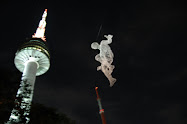
The weatherman lied. The forecast had called for a typhoon. It said the rice fields would be battered and blown by high winds and rain. But, instead, I woke to thin white smoke on a sky blue sheet, a real summer-in-Korea day—-hot in the early morning and full-on humidity.
The heat pushed me outdoors. I rode south toward the mountain for hiking and better air. I followed signs for Martyr’s Mountain (Chimyeongjasam, in Korean.) Parking, I read a sign that told me this was where seven martyrs were buried. They had died during an 1801 Catholic persecution, when Confucian standards opposed Catholicism.
I took the trail into the forest. A cross, two or three meters high, marked each grave along the trail as I ascended. I walked on a stepped path and not much about the terrain was rugged. But just to breathe hot air filtered through leaves of trees and hear birds fly and call was enough. Along the path (and in Korea this no longer strikes me as strange) were speakers hidden in the rocks and trees playing orchestral church songs.
The trail took me up alone until I came upon a group of Catholic nuns sitting on a bench in the shade. They served in a building carved into the mountain. They bowed, said hello in Korean, and I returned the greeting. I walked on thinking about the great lengths we go to for religion, how we move and shape the earth for it.
Onward up to the top of the mountain, where a rock stood exposed and marked with a cross. A woman stood looking up at the stone, peering into the cracks. She held her hands as though praying or meditating.
Behind her, the view from the rock overlooked the city and for the first time since coming to Jeonju I had a good map of the major landmarks. Beyond the city, where the buildings hadn’t spread, Korea summer mountains were verdant and deep green. I looked past the city to the American Kunsan Air Force Base, and farther, to the Yellow Sea.
As fortune would have it, I took another way down and happened upon a small Buddhist temple. Three tiled-roof temples with intricately painted exteriors were lined in a row. At their back, up the mountain, a smaller temple and a white, concrete Buddha completed the site. This Donggo temple was built over 1,100 years before I walked there and had undergone reconstruction after a Japanese invasion. Coming from such a relatively new country accented my appreciation for the age of Korean culture. I took a few pictures of Buddha’s mustache then walked down and filled my water bottle from a small waterfall.
As I left the temple I walked among bamboo forest and pine trees. I approached a man sitting under a tree. He was alone. He sat cross-legged on a fallen tree with his eyes closed. He looked at peace so I walked on, careful not to disturb him.
A slow creek told a story under a small bridge and I stopped to listen. The water spoke as it smoothed the stones. There were more birds in the trees. Then, and it wasn’t on the hour or for any reason I could discern, from deep in the woods through the grass and into the places where the sun didn’t reach, came the sound of a deep bell rung by hand. It rang in sets of three. Again and again, it rang deep and resonated through the mountains.





